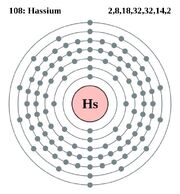
Hassium is an element with the symbol Hs and atomic number 108 and is the heaviest member of the group 8 (VIII) elements. The element was first observed in 1984.
Several isotopes are known with 269Hs being the longest-lived with a half-life of ~10 s. There is also tentative evidence for an isotope 277bHs with a measured half-life of ~16.5 minutes, which would make it one of the longest-lived superheavy nuclides.
Experiments to date have confirmed that hassium is a typical member of group 8 showing a stable +8 oxidation state, analogous to osmium.
Characteristics[]
Element 108 is projected to be the fifth member of the 6d series of transition metals and the heaviest member of group VIII in the Periodic Table, below iron, ruthenium and osmium. The latter two members of the group readily portray their group oxidation state of +8 and this state becomes more stable as the group is descended. Thus hassium is expected to form a stable +8 state. Osmium also shows stable +5, +4 and +3 states with the +4 state the most stable. For ruthenium, the +6, +5 and +3 states are stable with the +3 state being the most stable. Hassium is therefore expected to also show other stable lower oxidation states.
The group VIII elements show a very distinctive oxide chemistry which allows facile extrapolations to be made for hassium. All the lighter members have known or hypothetical tetroxides, MO4. The oxidising power decreases as one descends the group such that FeO4 is not known due to an extraordinary electron affinity which results in the formation of the well-known oxo-ion ferrate(VI), FeO42−. Ruthenium tetroxide, RuO4, formed by oxidation of ruthenium(VI) in acid, readily undergoes reduction to ruthenate(VI), RuO42−. Oxidation of Ruthenium metal in air forms the dioxide, RuO2. In contrast, osmium burns to form the stable tetroxide, OsO4, which complexes with hydroxide ion to form an osmium(VIII) -ate complex, [OsO4(OH)2]2−. Therefore, eka-osmium properties for hassium should be demonstrated by the formation of a volatile tetroxide HsO4, which undergoes complexation with hydroxide to form a hassate(VIII), [HsO4(OH)2]2−.
Value[]
The base value of each unit of ranges between 25 and 50Ð per unit, with up to 7 units being found at any one time.
Presence on Mars: Rare
| Martian Minerals | |
| Group 1 | Group 2 | Group 3 | Group 4 | Group 5 | Group 6 | |
| Group 5 | |Americium | Anthraximite | Areanetium Dieinsteinium | Areanetium Ferrocrete | Areanetium Mendelite | Berkelium | Bohrium | |Californium | Curium | Darmstadtium | Einsteinium | Fermium | Fermium Hasside | Ferro-plat Alloy | Hassium | Lawrencium | |Meitnerium | Meitnerium Golgathide | Mendelevium | Neptunium | Nobelium | Plutonium | Roentgenium | Seaborgium | |Transuranic Alloblast | |